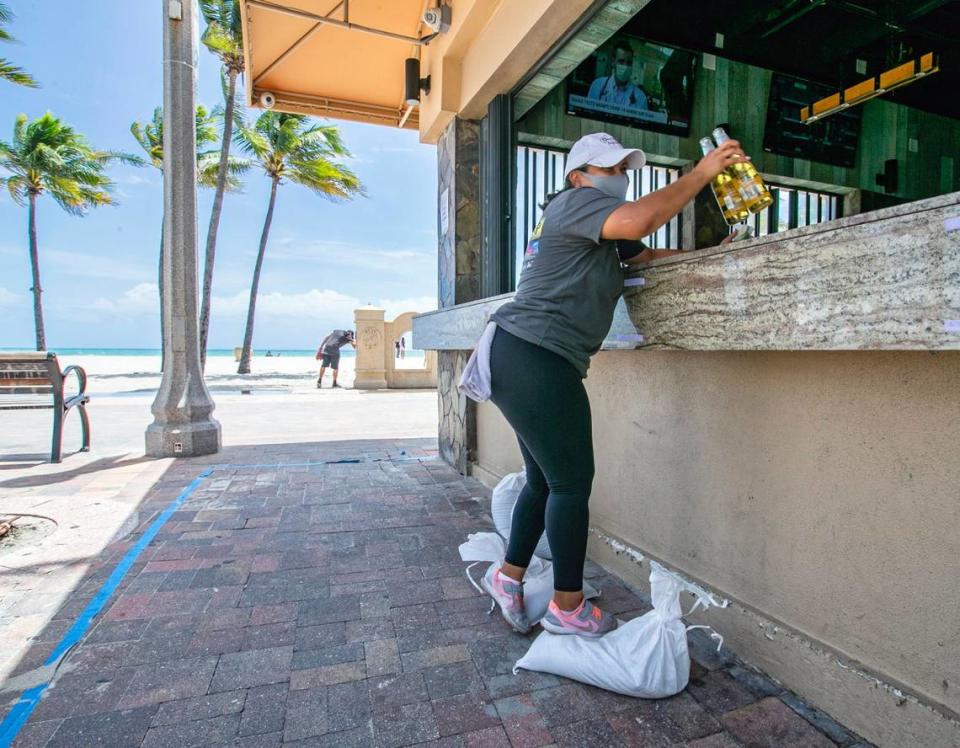Tropical Storm Isaias an ‘excellent test run’ for Florida ahead of peak hurricane season
Power has been restored. COVID-19 testing centers have re-opened. Hurricane and tropical storm warnings have been called off throughout the state.
In Miami-Dade, the buses never even stopped running, despite the Cat 1 hurricane looming several hundred miles offshore.
Tropical Storm Isaias gave South Florida its first brush with what promises to be an active — maybe even hyperactive — hurricane season. The region appears to have emerged with no lasting damage beyond downed palm fronds, and no serious test of the state’s plans for hurricane shelters during a pandemic.
“This was an excellent trial run. No harm done to anything, but we all got to get our hurricane hats on for a little bit,” said Brian McNoldy, a senior research associate at the University of Miami’s Rosenstiel School of Marine and Atmospheric Science.
Monday morning, Isaias crossed the border into Georgia without ever regaining hurricane strength, which it lost after a rough ride over the Bahamas’ Andros Island on Saturday.
Wind shear and dry air from the Sahara were a “one-two punch” to the storm, McNoldy said, and the only reason it’s still holding on to the possibility of a hurricane-force hit to the Carolinas is the warm waters of the Gulf Stream.
The conflicting forces “between the super warm water over the Gulf Stream saying ‘go, go, go, you can do it’ and at the same time it’s getting its head ripped off by the wind shear,” kept the storm ragged and disorganized for its crawl along Florida’s east coast on Sunday, McNoldy said.

The offshore storm still sent rough surf, drenching rain and tropical-storm-force winds to much of the Florida coast. Palm Beach and Brevard counties were under hurricane watches and briefly opened up shelters.
The Palm Beach Post reported that about 200 people sought shelter in Palm Beach. In Brevard, officials opened and closed a shelter within hours after only one person showed up, according to Florida Today.
Neither county reported having to segregate any potentially COVID-positive evacuees, a challenge emergency managers across Florida have planned for this hurricane season.
In Miami-Dade, officials plan to nearly double the space offered per evacuee to 36 square feet, screen for symptoms of COVID-19 and distribute masks, sanitizer and gloves to any potential evacuees. The county also said it plans to use fans equipped with ultraviolet lights to kill off coronavirus particles in mid-air.
Miami-Dade is currently leasing four such fans from a Fisher Island-based start-up called Sterile USA for $6,203, all of which appeared to be in use in the County’s Emergency Operations Center.
Coronavirus meets hurricane season as Florida adds hotels, screening to its shelter plan
Jared Moskowitz, head of Florida’s Department of Emergency Management, told the Miami Herald the state hopes to have rapid COVID tests available for peak hurricane season in mid-September.
“If the machines are available, FDEM will purchase them to give to the counties so they can do testing in the shelters, but our planning right now does not include rapid testing because it’s not rapidly available,” he said.
Steven Ippolito, a meteorologist at the National Weather Sevice’s Miami office, said the highest wind speed in South Florida was a 53 mph gust recorded at the Palm Beach Airport. In Miami, the highest wind speed recorded was 50 mph.
The rest of South Florida recorded winds in the high 30s and low 40s. The most rain was just under 2 inches recorded in South Lauderhill, he said.
By Monday afternoon, Florida Power & Light announced it had restored electricity to all 40,000 customers who lost power during the storm’s slow northward crawl. Most of the damage was from tree branches smacking into power lines.
The utility’s warning that coronavirus precautions like COVID screening and social distancing rules might slow down power restoration proved true. The average restoration time of 85 minutes per customer was indeed higher than the hour average for Hurricane Dorian, which knocked power out for 160,000 people.
NOAA calls for a busy 2020 hurricane season, with the possibility of ‘extreme activity’
NOAA has predicted that this could be an above-average hurricane season, with 13 to 19 named storms, 6 to ten hurricanes and 3 to 6 major hurricanes. So far this season there have been nine named storms and two hurricanes, although neither strengthened into major storms. The next name for a storm is Josephine.
The usual peak of the storm season is from mid-August to mid-November, when tropical waters warm and factors like Saharan dust, which helped keep Isaias at bay, weaken.
“It could have been a totally different storm a month from now,” McNoldy said.
Miami Herald staff writers Douglas Hanks and Ben Conarck contributed to this report.

